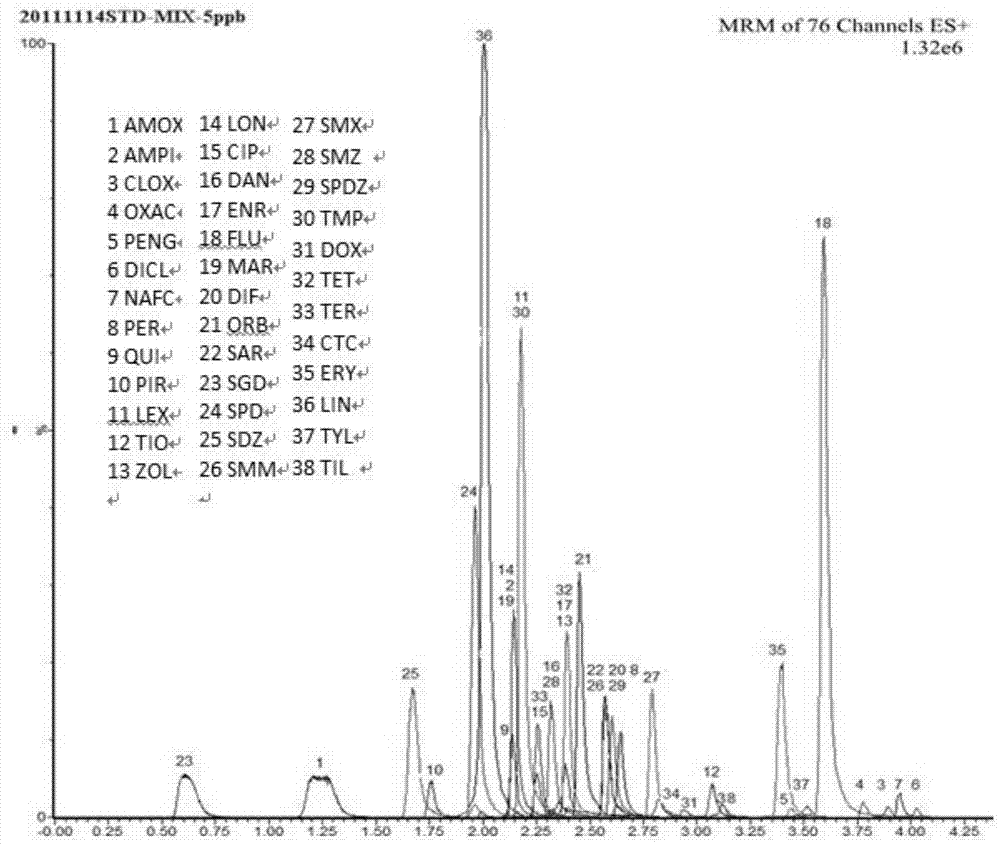UPLC-MS/MS simultaneous flux detection method for multiclass veterinary drug residue in raw fresh milk
A detection method and technology for veterinary drug residues are applied in the detection field of veterinary drug residues, which can solve the problems of complex pretreatment, single type of veterinary drugs, and difficulty in quantification.
- Summary
- Abstract
- Description
- Claims
- Application Information
AI Technical Summary
Problems solved by technology
Method used
Image
Examples
Embodiment 1
[0087] Example 1 Establishment of UPLC-MS / MS simultaneous throughput detection method for multiple groups of veterinary drug residues in fresh milk
[0088] 1. Experimental method
[0089] 1.1 Sample extraction and purification
[0090] Weigh 1g of milk sample, put it in a 10mL centrifuge tube, add 0.5mL of water and 3mL of acetonitrile, vortex for 5min, centrifuge at 10000r / min for 10min, take the supernatant in another 10mL centrifuge tube, blow nitrogen to 1mL, add 3mL NaH 2 PO 4 solution, adjust the pH to 8.5, and vortex for 5 minutes.
[0091] Sequentially use 2mL methanol, 2mL water, 2mL NaH 2 PO 4 (pH 8.5) solution to pre-activate the HLB solid-phase extraction column; after taking all the extracts through the column, successively use 2mL NaH 2 PO 4 (pH 8.5) solution, 1 mL of water, and finally eluted with 3 mL of 1:1 acetonitrile / water solution and 1 mL of acetonitrile. The collected solution was blown with nitrogen gas at 40°C until the volume was less than 1....
experiment example 1
[0108] Experimental example 1 Methodological validation of UPLC-MS / MS simultaneous throughput detection method for multiple groups of veterinary drug residues in fresh milk
[0109] According to the "NY / T 1896-2010 Laboratory Quality Control Specifications for Veterinary Drug Residues" issued by the Ministry of Agriculture of China, the European Commission's 2002 / 657 / EC "On Evaluation of Analytical Methods and Interpretation of Results in European Commission Resolution 96 / 23 / EC" and FDA's "About The Guidelines for Bioanalytical Procedures require that veterinary drug residue analysis methods need to be quality controlled and validated through limits of detection (LOD), limits of quantitation (LOQ), standard curves, recovery rates, and precision.
[0110] 1. Linear range and detection limit
[0111] Add different concentrations of mixed standard working solutions to the blank milk sample. According to the corresponding value and sensitivity of the instrument, the concentrations...
experiment example 2
[0135] Experimental Example 2 Sample Extraction and Optimization of Purification Conditions
[0136] 1. Optimization of sample extraction conditions
[0137] The main purpose of sample extraction is to remove milk protein and milk fat, and to dissolve the veterinary drug analytes in the sample to the greatest extent. According to the UPLC-MS / MS simultaneous flux detection method of multiple groups of veterinary drug residues established in Example 1, under the condition of other test conditions unchanged, the following three schemes were tested for sample extraction respectively:
[0138] A: 1mL of milk is directly diluted with 3mL of water, centrifuged at 10000r, and passed through the HLB column.
[0139] B: Dilute 1mL milk with 0.5mL water, add 3mL acetonitrile to precipitate protein, centrifuge at 10000r, pass through HLB column (equivalent to water: acetonitrile = 1:2).
[0140] C: Add 4mL acetonitrile directly to 1mL milk to precipitate protein, centrifuge at 10000r, a...
PUM
| Property | Measurement | Unit |
|---|---|---|
| specific surface area | aaaaa | aaaaa |
| pore size | aaaaa | aaaaa |
| particle size | aaaaa | aaaaa |
Abstract
Description
Claims
Application Information
 Login to View More
Login to View More - R&D
- Intellectual Property
- Life Sciences
- Materials
- Tech Scout
- Unparalleled Data Quality
- Higher Quality Content
- 60% Fewer Hallucinations
Browse by: Latest US Patents, China's latest patents, Technical Efficacy Thesaurus, Application Domain, Technology Topic, Popular Technical Reports.
© 2025 PatSnap. All rights reserved.Legal|Privacy policy|Modern Slavery Act Transparency Statement|Sitemap|About US| Contact US: help@patsnap.com



